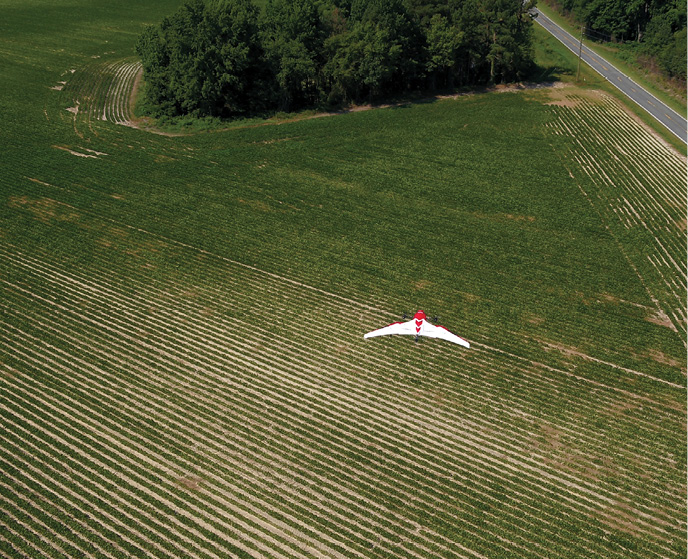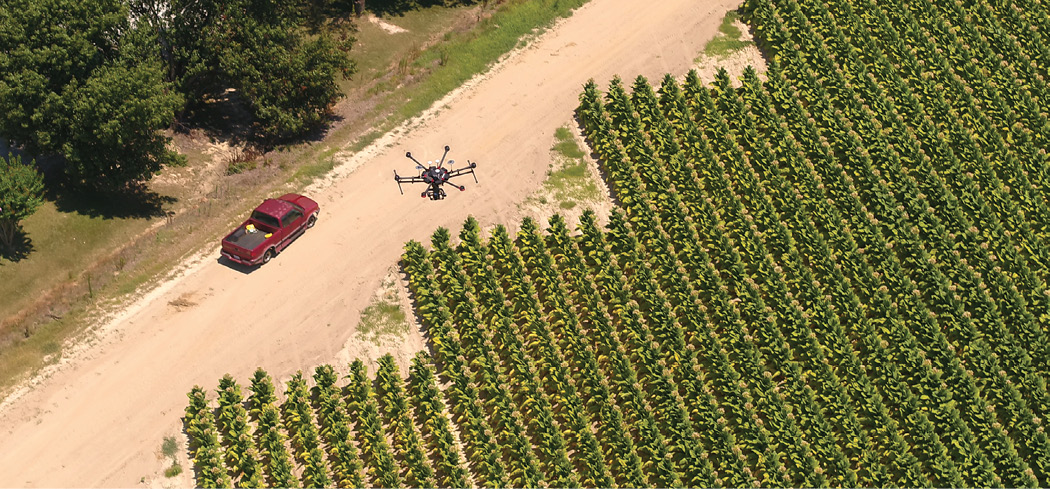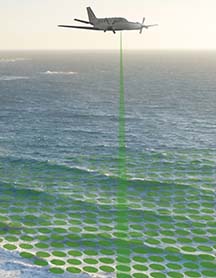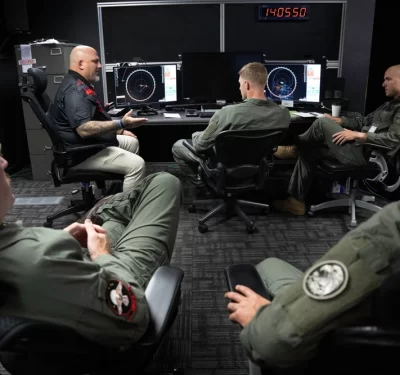
Unmanned aerial vehicles (UAVs) have found use in agriculture for decades, with unmanned helicopters spraying pesticides on rice fields in Japan back in the 1980s. Now, to have drones reach their full potential in farming, research is increasingly pushing toward beyond visual line of sight (BVLOS) operations.
Agriculture is a market second only to infrastructure in the global market for drone-powered solutions, according to a report from PriceWaterHouseCoopers in London. And, as the world population grows from 7 billion to an estimated 9 billion by 2050, agricultural consumption is predicted to increase by 69 percent.
UAVs are positioned to play an important role in overcoming what the PwC report stated was the main obstacle in farming—gathering useful insights on crops and livestock scattered across large areas of land in a manner timely enough to intervene quickly when needed. Drones with hyperspectral, multispectral, thermal and even just very high-resolution regular cameras can help farmers monitor their water, fertilizer, insecticide and herbicide needs more closely than satellites can, more cheaply than manned aircraft do and more regularly than both.
“As an ag pilot, I would wake up in the morning with, say, 10,000 acres to cover,” said Dennis Lott, CEO of drone consultancy firm UAS Solutions in Jackson, Mississippi, who collaborates on small UAS projects for agriculture at Mississippi State University. “That’s a tremendous area to work—I might only do 3,000 acres that day. That goes on for two to three months during the peak of the season. If drones can help collect data in real-time for the crop scouts—the agents that do field inspections for farmers—that makes them much more efficient at locating problems in the field.”
The hope is that drones can help farmers quickly and cheaply analyze plant status, added Amelia Fox, an assistant clinical professor of plant and soil sciences at Mississippi State University. “We want the right doses at the right places and right times,” said Fox, who teaches agricultural flight technologies and is exploring how color and near-infrared sensors can help farmers analyze plant status.
But all this requires coming to grips with flying beyond line of sight. “If we want to really have UAVs embraced at a productive scale in agriculture, drones operating BVLOS is going to become important to cover more area,” said Bobby Vick, director of agriculture at PrecisionHawk, a drone and data company in Raleigh, North Carolina.
THE NEED TO FLY BEYOND VISUAL LINE OF SIGHT
The potential value drones have for farming has largely been stymied because the Federal Aviation Administration (FAA) currently limits unmanned aircraft to fly within visual line of sight of their pilots in the United States.
“You can’t cover the acreage needed to be covered with those restrictions,” Lott said. “With visual line of sight one can see only about 2,500 feet, more or less, so I might be able to cover a mile end to end if I was standing in the middle of the field. You can’t cover the fields that need to be covered efficiently if you have to constantly reposition yourself. It’s just not a productive way to utilize an aircraft, to give farmers the information they need at the most reasonable, economic rate possible. It’s a real hindrance to the successful growth of UAS in the ag community when you are limited to visual line of sight.”
As such, the drone industry has long pushed for beyond line of sight operations. “It’s all about reducing the cost of information acquisition,” said Michael Ritter, CEO of San Diego-based SlantRange. “At present, one operator per system is required within visual line of sight, which, depending on your aircraft type, might be up to about one kilometer.”
With BVLOS, drones can operate across larger areas. SlantRange has estimated BVLOS can drive the cost of data acquisition down by more than 10 times, Ritter said. “We simply have to go the distance,” Lott added.
Flying BVLOS can prove especially helpful for large perennial crops such as trees. “It is not uncommon for tree crops such as fruit or nut trees to come in large contiguous groves in Florida and California that go on for miles,” Vick said, “It’s hard to conduct large-scale operations in areas covering hundreds or thousands of acres if pilots have to constantly move from one point to another, especially since the height of the trees can impede visual line of sight more than with row crops such as corn or wheat that are lower to the ground.”
Ultimately, the hope is that BVLOS capabilities may lead to fully autonomous operations. In this scenario, “drones may be tasked from a centralized planning function to survey thousands of acres per day without the need for human intervention,” Ritter said.
BVLOS operations can use techniques developed for big data to produce deep insights for the agriculture sector. For example, Ritter noted that Microsoft’s FarmBeats project has farms hosting computers where artificial intelligence (AI) software can analyze agricultural data.
When it comes to farms with limited network connectivity that might face difficulties uploading and downloading vast amounts of information for analysis, Ritter suggested they might want to process what data they gather directly on site, especially “when time is critical and they can’t wait overnight for results.” On the other hand, he noted major agricultural service providers with global operations may want centralized data processing centers that subsidiaries can send data to over the cloud for analyses with greater scopes.

EXPANDING BVLOS OPERATIONS
For drones to make the most of BVLOS operations, they will have to be able to fly for long times to cover large areas. “Fixed-wing flight systems are far more efficient than multi-rotor ones, have longer endurance with similar amounts of power, but it can be difficult to take off and land with them,” Ritter said. “I think VTOL [vertical take-off and landing] systems that can transition to more efficient fixed-wing flight will become the default.” Larger multi-rotor drones, Vick suggested, may also find use carrying heavier payloads.
BVLOS farm drones will likely also grow large. “Sizes will likely tend toward the maximum allowable under small UAS rules to maximize capacity for on-board power and endurance, component redundancy for safety and reliability, longer range communications systems, traffic deconfliction,” Ritter said. To maximize flight time, BVLOS aircraft may also tend toward hybrid propulsion using a fuel cell or an internal combustion engine in addition to batteries, Vick added.
Of course, the FAA wants to ensure such operations are as safe as possible for others in the air and on the ground. There are far fewer people on farmland than in cities, and so in that respect agricultural applications lessen chances of injury. Still, rural settings may introduce other safety challenges, such as low-flying crop dusters, Vick said.
“Manned aircraft operators are supposed to fly 500 feet or higher going cross-country, but in general, ag pilots don’t do that—they just fly over treetops and don’t waste time climbing to altitude, and many don’t want to hear that they have to fly according to the rules,” said Lott, the ag pilot. “Drones are supposed to fly up to a maximum of 400 feet or so, so if drones are flying in their space and ag pilots are flying in their space, that’s 100 feet of altitude separation and all good. But in the middle of farm country, that might not be the case. Manned aircraft are big, and can be seen and heard fairly easily, but if they’re moving at 160 miles per hour, they can be on you before you know it.”
A potential way to incorporate drones into airspace is Automatic Dependent Surveillance—Broadcast (ADS-B), an internationally standardized aviation technology that broadcasts an aircraft’s ID, type, position, altitude, direction and speed using GPS data. Aircraft equipped with ADS-B that transmit such data have what is called ADS-B Out; an aircraft that can also receive this data has what is called ADS-B In.
Just this January, the FAA made it mandatory for manned aircraft operating in most U.S. airspace to carry ADS-B Out transmitters. Other nations have similar ADS-B requirements either already in place or on the horizon. (For a technical overview of how adoption might roll out for UAVs, see the “General Overview” column in the December-January issue of this magazine.)
“If every manned aircraft had ADS-B Out transmitting their position, and every unmanned aircraft had ADS-B In, then the drone autopilot systems could, for instance, set a buffer zone with a radius of maybe five or 10 miles and see intruders into those zones a mile or two away and automatically take avoidance maneuvers to get out of the way,” Lott said. Indeed, DJI pledged to add ADS-B In receivers to all its models released after January 1 of this year that weigh more than 250 grams.
Having drones rely on onboard acoustic, visual and other sensors to detect and avoid collisions is another strategy, “but can prove challenging to implement, especially with a lightweight system like you would want on a drone,” Ritter said. Still, Vick could see drones equipped with both sense-and-avoid and ADS-B systems, “since you would want redundant systems in case one failed.”
There remain open questions as to what procedures drones should take if they do sense a collision—“do they hover and remain stationary, or do they take evasive maneuvers, or do they return home?” Vick said. “And is the operator involved in that decision, or is it entirely an autonomous decision made, no pun intended, on the fly? If we lose comms, how does the aircraft respond? A lot of investigation still needs to be done to carry out BVLOS in a safe manner, but the applications are unlimited once we have those items resolved.”
THE FUTURE OF BVLOS
“Remote ID is key to operating beyond the visual line of sight,” Lott said.
The most recent step toward U.S. implementation of BVLOS came at the end of 2019, when the FAA issued a notice of proposed rulemaking concerning a way to remotely identify unmanned aircraft. Such remote ID systems would act much like electronic license plates that drones could use to identify themselves to remote observers.
“I have done extensive testing in a manned aircraft to see how well one could visually ID an unmanned aircraft, and it is extremely difficult,” Lott said. “It is not an impossibility, but it is nearly impossible for a pilot to see an unmanned aircraft until near collision. I’ve tested it from 1,000 feet and from a helicopter in a slow hover, and I knew where the drone aircraft was, and I couldn’t find it. So it’s completely understandable why the FAA wants drones to have remote ID capability.”
Remote ID systems would help lay the foundation toward a UAS traffic management (UTM) system scalable across the entire national airspace, the FAA noted. The comment period to solicit public feedback on the FAA’s newly proposed remote ID rule closes March 2. (Previous efforts to develop international remote ID standards were detailed with regard to drone applications in the energy industry in the October/November issue of this magazine.)
Last year also saw the FAA approve the first commercial BVLOS drone operation in the U.S. using only onboard detect-and-avoid systems. In November, the Kansas Department of Transportation’s Unmanned Aircraft Systems Integration Pilot Program conducted a nine-mile flight to inspect power lines in collaboration with Evergy, the state’s largest energy provider. In the first two days of flights, the team successfully completed more than 150 miles of BVLOS flying using a fixed-wing drone equipped with Casia, a detect-and-avoid system from San Francisco-based Iris Automation. Casia senses, tracks and classifies other aircraft, makes decisions about the risk they may pose, triggers automated maneuvers to avoid collisions and alerts the pilot in command of the mission about what is happening.
Still, all in all, little major public news has appeared recently concerning BVLOS advances in farming. “The problem is timing and investment,” Ritter added. “The timing of BVLOS regulatory approval is uncertain, and the venture investments needed to drive the technology forward typically operate on time horizons that require returns before BVLOS may be a reality.”
“We’ve already seen some promising technology from new ventures aimed at BVLOS that ultimately flamed out waiting for regulations to change,” Ritter said. “I’ve known of companies out there working toward fully autonomous drone solutions that do not require any human servicing whatsoever, but after they raise funds from investors, they might have 18 to 24 months of runway, and regulations might be three to five years off.”
Still, Ritter saw a path to the future. “For investors who are comfortable with the longer time horizons, I think there will be substantial returns. I think the technical path to achieving this future is clear and relatively low-risk given what’s already been achieved in other BVLOS environments—that is, defense.”
“BVLOS is very popular, but it is at its infancy,” Vick concluded. “But that doesn’t mean that BVLOS applications for agriculture are not on the horizon.”






